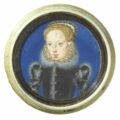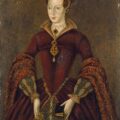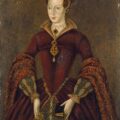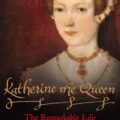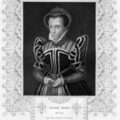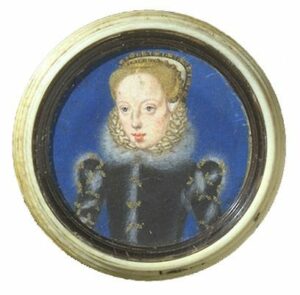
“The Sisters Who Would Be Queen” looks at the lives of Lady Jane Grey, Katherine Grey and Mary Grey, and challenges the myths surrounding Jane and the family. It is a marvellous book and I heartily recommend it.
Katherine Grey – Heir to Elizabeth by Leanda de Lisle
Imagine you are eighteen. Your home is lost, your sister and father executed. But you have survived the reign of Mary Tudor to emerge as Queen Elizabeth’s heir. In November 1558 such was the position of Lady Katherine Grey, sister of Jane, the iconic Nine Days Queen. But her dramatic life was to be erased from national memory, along with the secret it told.
To uncover this secret we must back to that summer of 1558, and the dying months of Mary Tudor’s reign. Katherine, blonde and pretty, was permitted briefly to nurse a sick friend in the house of the girl’s mother. Her friend’s nineteen year old brother, ‘Ned’ Seymour, Earl of Hertford, was also there, and during the course of that hot country house summer, they fell in love. Katherine and Ned were warned their romance was dangerous. Under the will of Katherine’s great uncle, Henry VIII, backed by English law, Katherine followed Elizabeth in line to the throne, and was a possible rival.
This is not, of course, how history remembers it. Mary, Queen of Scots is the cousin we recall as Elizabeth’s heir. But Henry VIII had excluded the entire Stuart line of his elder sister, Margaret of Scotland, from the succession and in their stead placed the heirs of his younger sister, Mary Rose Tudor – Katherine’s grandmother. If Henry’s will, and the 1536 statute that supported it, had not existed, Mary, Queen of Scots would also had the superior right to Elizabeth. As the illegitimate daughter of Henry’s annulled marriage to Anne Boleyn, Elizabeth had no claim to the throne under the traditional rules of primogeniture. To accept Elizabeth’s right to become Queen is to accept Katherine’s right in line of succession. And that right would be strengthened by marriage.
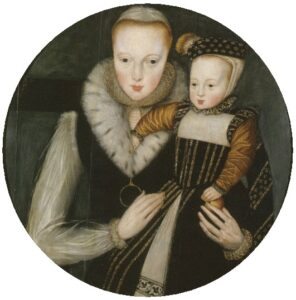
It was possible even that Elizabeth’s Protestant supporters would prefer a married Katherine to a virgin Elizabeth. Indeed, they had form in this regard. Five years earlier, in 1553, King Henry’s son, the Protestant Edward VI, had cut his half sisters, Mary and Elizabeth, out of his will, and bequeathed his throne to his cousin Lady Jane Grey – Katherine’s elder sister. Other Protestants had backed his decision, principally because Mary Tudor was a Catholic. But also because the Tudor sisters were unmarried, while Jane Grey had a husband. Female rule was considered against the natural order: a punishment from God made tolerable by a Queen’s willingness to marry with the object of her producing male heirs. And to whom she was married was of vital importance.
Edward drew attention specifically to the dangers of his half sisters marrying foreigners, while giving his seal of approval to Jane Grey’s marriage to Lord Guildford Dudley, a son of the Lord President of his Privy Council, John Dudley, Duke of Northumberland. Unfortunately for Jane, however, many amongst the elite and the wider population, envied and hated Northumberland, who was accused later of plotting to rule England through his son. Mary Tudor was able to overthrow Jane after only thirteen days – nine after she was proclaimed Queen in London – a fact that was poor consolation for the young Queen Elizabeth. She was in love with Guildford’s brother, Robert.
Elizabeth did not trust Katherine or her Protestant supporters. And Elizabeth believed that for her own security she would have to make sure Katherine never had a male heir.
But at Queen Mary’s death Queen Elizabeth was blissfully ignorant of Katherine’s romance. And she remained too busy pursuing her own passion for Robert Dudley to notice the affair continuing under her nose. After two years Katherine and Ned married secretly. The transcripts of later interviews in the Tower describe their wedding night in intimate detail. Katherine married Ned in his bedroom at a house on the Thames, with only his sister as witness. They toasted their wedding quickly and rushed to bed. They made love twice, with Katherine naked save for a fashionable headdress. Then they dashed back to court, so they wouldn’t be missed.
Over the following months the couple had sex in all the Queen’s palaces. Katherine became pregnant, but frightened of the possible consequences, she couldn’t accept it. So when Ned was offered a trip around Europe, Katherine agreed he could go. It was only when she was eight months pregnant that she confessed to Robert Dudley that she was to have a child. Elizabeth promptly threw Katherine in the Tower, and Ned, recalled from Europe, was also imprisoned.
The fact the Ned had some royal blood and was the son of the Protector Somerset, who had brought Protestantism to England, made Katherine’s marriage all the more threatening to Elizabeth. But her anger could not stop the birth of Katherine’s son, Lord Beauchamp, in the Tower that September of 1561. Elizabeth ordered a Church commission find Katherine’s marriage invalid – and as the only witness to the wedding had since died she was successful. But sympathetic warders in the Tower allowed Ned to corridor creep to Katherine’s cell and the striped satins that covered her bed. Just as Elizabeth had succeeded in having Katherine’s first son declared a bastard, Katherine gave birth to a second son.
Elizabeth had the Lieutenant of the Tower put in his own prison for his laxity, and the couple were separated in different country house prisons. Katherine was frank about how much she now missed their love making. In a letter she tells her ‘Ned’ how ‘I long to be merry with you’, as they were when their son was conceived: ‘I remember it more often that you know’. She looked forward desperately to seeing, ‘ my sweet bedfellow, that I once lay beside with joyful heart, and shall again’. But Katherine never would lie beside Ned again. While Elizabeth’s own Secretary of State, William Cecil, and many members of Parliament, battled to persuade her to confirm Katherine as her heir, the unmarried Virgin Queen left her fertile cousin to rot.
At the years passed Katherine fell into despair at her continued separation from Ned and her elder son. Finally, in January 1568 Katherine’s warder sent a letter asking for the royal doctor to help her. It was too late. Katherine begged the warder to send Ned a last gift: a ring engraved, ‘While I lived, Yours’, and then died aged only twenty-eight. Katherine was buried in a little chapel in Yoxford, Suffolk. Local legend has it that her toy dog pined on her grave until he too died. But Ned survived and was freed in 1571, still hoping his elder son, Lord Beauchamp, would one day be King.
At nineteen, Beauchamp fell in love in the same house his parents had – but with a gentlewoman not considered grand enough to be future Queen consort. Elizabeth, delighted, gave the marriage her blessing, in order to destroy Beauchamp’s chances for the crown. Elizabeth always hoped a Stuart would inherit her throne. The Stuarts were excluded from the English throne under Henry VIII’s will and by law. But as descendants of Henry’s elder sister, their royal line was senior to that of the Greys, descendents of his younger sister. To Elizabeth this represented the divine right to rule over the power of parliament – a power she had always feared would be used against her, in Katherine’s favour.
In the end, having destroyed Katherine Grey, Elizabeth got her way, and it was James Stuart, the son of Mary, Queen of Scots, who succeeded Elizabeth in 1603. Ned lived long enough to see how unpopular James I became. He died aged 84, over fifty years after Katherine. Their grandson, William Seymour, then disinterred Katherine’s body and buried them together in a magnificent tomb in Salisbury cathedral. The engraved words record how after the vicissitudes of fortune the star-crossed lovers were re-united at last; the Queen who never was lying above her husband to mark her royal status.
Katherine’s story was, and remains, a reminder of the argument that the Stuarts came to the throne illegally. So it was buried with her. Katherine’s heir today is reputed to be the aristocrat Lady Kinloss: under the will of Henry VIII – whose 500th anniversary falls this year – the rightful Queen of England.
Leanda’s Book
“The Sisters Who Would Be Queen” is available to buy from Amazon UK, Amazon US or your favourite book retailer.
